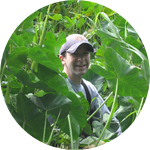About This Project
Per- and polyfluoroalklyl substances (PFASs) are commonly used in manufacture of everyday items (food packaging, nonstick cookware, stain-resistant fabrics). PFAS are persistent and ubiquitous in nature, and low levels have been detected in blood of humans and wildlife around the globe. Therefore, there is considerable interest in assessing potential adverse health effects of increased exposure. This project will assess sublethal effects of PFASs on amphibian communities and ecosystems.
Ask the Scientists
Join The DiscussionWhat is the context of this research?
Global amphibian biodiversity has declined at an alarming rate over the last 20 years. This has led to international regulations regarding exposure to chemical contaminants, including industrial wastes. In particular, poly- and perfluoroalkyl substances (PFASs) are prevalent due to their high water solubility, mobility in soils and sediments, and persistence in the environment. Therefore, PFASs pose a potential risk to amphibians in their aquatic and terrestrial habitats. However, basic information such as lethal concentrations for most PFASs is lacking for amphibian species. Our proposed research will provide these data which are critically important for risk assessment and remediation.
What is the significance of this project?
Larval amphibians are an important consumer in many freshwater systems and can have dramatic effects on algal biomass and species composition. Furthermore, metamorphosing larvae and breeding adults can play a significant role in the transfer of energy between freshwater and terrestrial ecosystems through seasonal emergence and migration. Our proposed research will provide essential information on the acute and chronic toxicity of PFASs on amphibian taxa. Furthermore, we will integrate our knowledge of PFAS toxicity into an ecological framework by assessing potential effects of exposure on amphibian behavior and species interactions. Evaluating effects of PFAS exposure on behavior could provide a rapid and sensitive alternative to classical ecotoxicological approaches.
What are the goals of the project?
The central goal of our proposed research is to examine the lethal and sublethal effects of specific PFASs on amphibian behavior, growth, and development. We will use a combination of acute (96-hour LC50 – lowest concentration that results in 50% mortality) and chronic (21-day) toxicity tests, in addition to assessing amphibian foraging and predator avoidance behaviors in response to PFAS exposure. Amphibian species for the proposed experiments include Northern Leopard Frogs (Lithobates pipiens), American Toads (Anaxyrus americanus), and American bullfrogs (Lithobates catesbeiana). These species are representative of the most prevalent amphibian families in North America (Ranidae and Bufonidae). We plan to start experiments in fall 2016.
Budget
Baseline Funding: We are requesting funding to cover the costs of purchasing experimental aquaria (sterilite tubs) and units (plastic cups). We also need to purchase each of the target PFASs that we are interested in studying. Perfluoroctane sulfonate (PFOS), perfluorooctanoic acid (PFOA), and perfluorohexane sulfonate (PFHxS) are among the most commonly used PFASs and are commonly detected in nature. As PFOA is an acid, we are requesting funds to buy a small pH probe to standardize acidity/pH across chemicals and levels. Formalin and ethanol are used to preserve experimental animals for analysis. Finally, we are requesting funds to support an undergraduate student (Stephanie Bauer) who will be working on this research for her honors graduation project.
Endorsed by
Meet the Team
Team Bio
The team includes researchers from Purdue University with expertise in ecotoxicology, amphibian community ecology, and freshwater ecosystems, in general. Collectively, our laboratories have studied the ecological impacts of a variety of environmental stressors and pollutants on diverse organisms (birds, reptiles, amphibians, and fish).
Michael Chislock
I am a postdoctoral fellow in the Department of Forestry and Natural Resources at Purdue University. My general interest is in studying the consequences of human activities (including contaminants) for aquatic communities and ecosystems, using observational surveys and manipulative experiments. I have worked with a variety of organisms including fish, amphibians, invertebrates, and algae in the southeastern, mid-western, and northeastern United States.
Jason Hoverman
My research program focuses on environmental stressors in aquatic ecosystems. By combining laboratory and mesocosm experiments with broad-scale field surveys, I seek to identify the mechanisms through which different environmental stressors affect individuals, species interactions, and community structure and function. The current focus of my research includes: 1) the long-term importance of predator stress for prey and their communities, 2) the dynamics of disease transmission within communities composed of multiple hosts and multiple pathogens, and 3) the application of an ecological framework to understand the interactive effects of natural and chemical stressors on ecological communities. To address my research interests, I utilize freshwater aquatic systems (e.g., ponds, wetlands, and lakes) and their associated taxa (e.g., tadpoles, snails, insects, fish, parasites).
Maria Sepulveda
I am a Professor of Ecotoxicology and Aquatic Animal Health in the Department of Forestry and Natural Resources at Purdue University. My research focuses on studying the impacts of pollutants on aquatic organisms. My laboratory also studies the mechanisms by which contaminants exert their effects. I have worked with different aquatic organisms including marine mammals, wading birds, fish, turtles, alligators, frogs and aquatic insects. I am currently mentoring 3 PhD, 2 MS and 2 undergraduate students.
Lab Notes
Nothing posted yet.
Project Backers
- 5Backers
- 2%Funded
- $35Total Donations
- $7.00Average Donation




